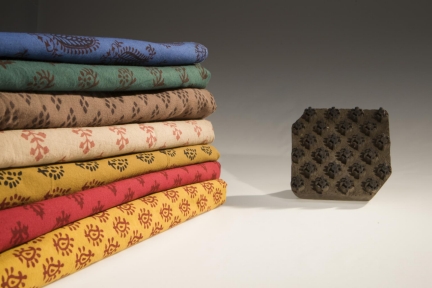
Sorry, we couldn't find anything that matches your search.
Destination

Famous Places to Explore in Hyderabad
A vibrant city with the imposing...

Raipur Tourist Places | Best Place to Visit
The stronghold of several erstwhile...

Ahmedabad
Declared as India's first UNESCO World...
#
Screen Print
A beautiful art, screen printing is the method of forcing ink or paint into a fine surface cloth to make decorative patterns. It can be practiced on a diverse range of surfaces. Screen printing made its big entry into the world of art in the 1960s. The technique, in essence, uses a mould that is prepared on a metal frame and is used for screen printing. After the cloth is secured from all sides, photosensitive chemicals are applied to it to get desired results. The process is traditionally known as serigraphy. Earlier, silk was used for this kind of printing but now there is heavy usage of synthetic threads. A mesh is used to transfer ink onto a substrate (underlying layer of the cloth). There are areas though that are made impermeable by the use of a blocking stencil. A blade is then moved across the screen to fill the open mesh with ink and reverse stroke causes the screen to touch the substrate. The colour is printed after several repetitions of the process; one can also print multicoloured images in this way.

Bagh Print
Native to the town of Bagh, in Madhya Pradesh, this type of printing is done manually by repeatedly washing, dyeing and then printing. Firstly, the fabric is soaked in water all night and then dried in the sun for long hours. It is then dipped in a large vat of castor oil, raw salt and water. After this, it is washed with water and all of these steps are repeated three times. Finally, the fabric undergoes dyeing. Colours used for dyeing and printing are obtained from flowers, fruits and seeds. While red colour is obtained by simmering a mixture of alum and tamarind seeds, black colour is taken from a mixture of iron, jaggery and water that has been stored for a month.

Bhairavgarh Print
The town of Bhairavgarh is popularly known for the ancient art of Bhairavgarh print, which is noted for its perfect symmetry. The technique is believed to have been in use in India for more than 200 years now. The print uses melted wax to create pretty motifs of leaves and flowers, spiralling creepers and intricate doodles in shades of yellow and red.
In the process, vats of wax are slowly heated on gas, and then taken to sand-covered tables where wax patterns are drawn on a cloth. With a stylus made by tying coconut husk on a metal rod, craftsmen draw out wax patterns on the fabric. In earlier times, the patterns were created with blocks made of potatoes. These blocks were later replaced with wooden ones. Once the wax on the fabric dries, it undergoes dyeing. All types of fabrics can be used for this print. Natural dyes are used only rarely, usually for Kalamkari designs, but other than that, the use of vivid chemical dyes is prevalent.

Batik Print
Batik Print uses a technique where hot and melted wax is used for resistant-dyeing. Lines or dots are drawn where you want to avoid the dye colour from spreading on the garment. At those spots, wax is applied with a brush or a pen, usually a spouting tool called tjanting/canting is used; for large and broad patterns alternatively a stiff brush is used. There is another drawing technique that uses stamps where the patterns are broad and very simple. The patterns need to be drawn on both sides of the garment. The cloth is first washed and then beaten with a mallet. After the patterns have been drawn on it, the cloth undergoes dyeing in a colour of one's choice. The wax is then removed with boiling water. After the resist is removed, the original colour of the garment forms a stark contrast to the dyed, coloured area. Since the wax resists the dye, the end result is a stunning garment with creative and intricate patterns. The process is repeated several times depending on the desired colour. The traditional type of design is called batik tulis written batik. Batik Prints are very popular in the holy city of Ujjain.

Bandhej Print
Involving a complicated print, Bandhej is done by randomly tying a cloth into knots. This cloth is then dipped into dyes to give it different colours and patterns. Bandhej produces a variety of patterns like chandrakala, bavan baug, shikari, depending on the manner in which the cloth is tied. Bandhej is the oldest form of tie and dye art and according to historical evidence, the first Bandhej print saree was worn at the time of Bana Bhatt`s Harshacharita.
Red, yellow, green, blue and black are the most prominently used colours in this print; the use of red colour is even meant to bring good luck to newlyweds! Though dyers have experimented with various elements, both natural and man-made, they have mostly stuck to organic dyes in this art form. Bandhej printed sarees are a very popular choice for women in the state and are of very fine quality. They are light, breezy and very elegant.





